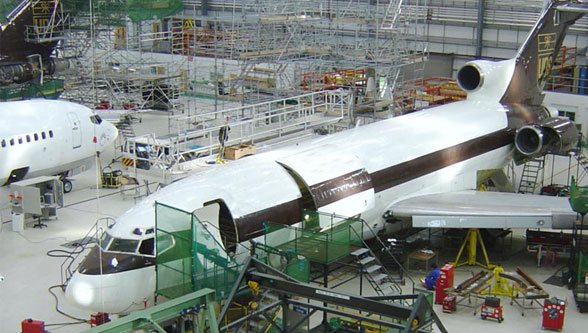For decades, just a handful of materials have been the go-to in the aerospace and aircraft development industry. Aluminum and similar metals have made up the bulk of your average aircraft because of their incredibly low density.
In fact, Junkers’ first all-metal design was constructed using corrugated panels of sheet steel, which ended up being too heavy. The design was later swapped for aluminum, a similar yet less dense material that also cost much less.
It became increasingly common in the industry over time—its reign was established by its incredible ratio of durability to density. By the time composite materials made a difference in the manufacturing and development world, those working on aircraft had become too reliant on aluminum. Thus, it just naturally became the primary building component of most aircraft.
According to a Markets and Markets report, about 50 percent of the aerospace materials market, by volume, is comprised of aluminum.
Introducing Modern Composites
In recent years, that’s changed almost completely. This is because carbon composites provide a much stronger density than aluminum—by as much as 60 percent—making for a more durable yet lightweight material.
Carbon composites are also incredibly versatile, and can be formed and shaped into unique factors not traditionally possible with metallic components. Regarding design, this allows for larger, more complex parts that eliminate the need for additional fuselage components. It also mitigates the use of fasteners and joints, paving the way for improved aerodynamics.
However, carbon composites aren’t the only relatively new and innovative materials making an impact in the industry.
What Other Materials Are Being Used?
Other materials such as titanium, beryllium and composite-based aluminum are being used for modern aircraft. What’s special about modern designs, in particular, is the materials are personalized to the craft and area of the body where they are being used.
In the nose of an aircraft, for instance, the material must be able to withstand shock and impact, primarily from bird strikes. However, this is not as much of a concern in the rear of the craft, such as the wings. A modern craft might be developed to include one form of material in the cone and another in the wing better suited for wind turbulence and common flight patterns.
Titanium especially can make a huge impact in the industry, and may become the new go-to material from 2019 and beyond. Other metals—like beryllium— that were considered too exotic and expensive in the past are being used to develop craft such as Lockheed Martin’s F-35 Lightning II.
The alloy and composite materials provide a less dense structure, with more versatility and maneuverability, without sacrificing durability. Less dense materials also provide incredible cost savings in both flight and usage scenarios. The F-35 Lightning II has delivered a 60 percent reduction in unit recurring flyway costs since previous generations.
Perhaps more important than all the other benefits is the safety and durability of these new alloys, especially when it comes to flammability and heat resistance. Fire and flammability testing is a crucial component of aircraft development and design. If the materials used cannot withstand appropriate temperature changes, then the resulting aircraft is obviously going to be extremely dangerous.
Modern alloys and composites, however, offer incredible heat resistance and fire reduction ratings, which contributes to the increase in safety and reliability newer crafts benefit from.
It should come as no surprise that these new materials and design specifications are disrupting the aerospace and flight industry. More efficient, cost-friendly and increasingly durable craft are the greatest benefits offered by the newer and modern materials currently being deployed in the industry.
Article by —

Megan Ray Nichols
Freelance Science Writer
[email protected]
www.schooledbyscience.com/about
[gap height=”20″]



